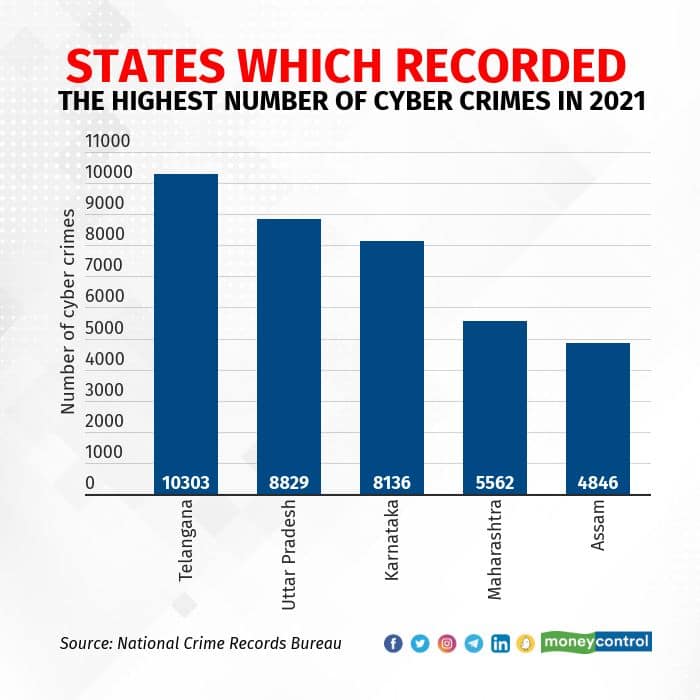Overview
In 2022, the National Crime Records Bureau (NCRB) revealed a notable increase of 24.4% in cybercrime incidents compared to the previous year.
The latest data, released on 3 December 2023, highlights a surge in these digital offences. Karnataka, Telangana, and Maharashtra, relatively affluent states, contribute to more than half of the reported cases.
What is Cybercrime?
Cybercrime, in essence, refers to criminal activities that revolve around utilising or targeting computers, computer networks, or networked devices. Perpetrators of cybercrime, commonly known as cybercriminals or hackers, engage in these activities with various motives, often centred around financial gain.

Rising Trends of Cybercrime Cases : A Closer Look at NCRB’s Latest Data
In 2022, the landscape of cybercrime in India witnessed a significant surge, with 65,983 cases registered nationwide.
This marked a substantial increase from the 52,974 cases recorded in the preceding year, 2021, which showed an 11.8% growth from 2020.
The reported cases encompass a spectrum of offences involving using computers or the internet as tools to perpetrate crimes or target victims. These offences span categories outlined in both the Indian Penal Code (IPC) and the Information Technology Act, encompassing activities such as fraud, ransomware attacks, and impersonation.
The cybercrime rate, calculated at 3.9 cases per hundred thousand people in 2021, witnessed a notable uptick, reaching 4.8 in 2022, as per the NCRB report.

Breaking down the state-wise figures, Telangana emerged with the highest cybercrime rate at 40.4, followed by Karnataka at 18.6 and Maharashtra at 6.6. Conversely, states like Himachal Pradesh and Madhya Pradesh reported the lowest cybercrime rates.
The recent statistics align with a discernible uptick in these crimes. A trend expert attributes this to the expanding reach of the internet and mobile usage.
Over the last decade, cybercrime cases skyrocketed from 3,693 in 2012 to 65,893. During this period, the prevalence of mobile internet users surged from approximately 12.5% of the population to a substantial 76.6%, as per data shared by the Telecom Ministry with Parliament.
India’s National Cyber Crime Reporting Portal offers a vital channel for individuals to report prevalent cybercrimes, including bank account thefts and mobile wallet frauds. However, recent data reveals a stark contrast between reported cases and those officially registered by the police.
Between January 2020 and December 2022, the portal amassed a substantial 1.6 million cybercrime complaints. Surprisingly, only 32,000 of these complaints translated into registered police cases, according to information disclosed in a Union Home Ministry Right to Information (RTI) response.

Delving into regional statistics, Delhi accounted for 1.2% of cybercrime complaints received between January 2022 and March 2023. Telangana and Karnataka emerged as notable contributors, registering cases in 17% and 18% of the complaints. Other states reported varying percentages, with Meghalaya at 8%, Assam at 2.7%, and Tamil Nadu at 2.2%.
The RTI findings find resonance in the National Crime Records Bureau (NCRB) report, where Telangana recorded the highest number of cybercrime cases (15,297), trailed by Karnataka (12,556) and Maharashtra (8,249). These three states also boast the highest cybercrime rates in the country.
How do we protect ourselves from cybercrime?

- Regularly update your software and operating system to benefit from the latest security patches.
- Employ reliable anti-virus software.
- Create unique passwords or use a reputable password manager to enhance security.
- Never open attachments or click on links in spam emails from unknown senders.
- Be cautious of unfamiliar or suspicious website URLs, especially when conducting online transactions.
- Report cybercrime incidents to the National Cyber Crime Reporting Portal for effective action.
- In addition to providing a platform for reporting cybercrimes, the National Cyber Crime Reporting Portal offers daily digests. These briefings serve as a valuable resource, keeping individuals informed about the latest developments and trends in the cybercrime landscape.
- Stay vigilant and informed about evolving cyber threats to protect yourself online.












Comments 2